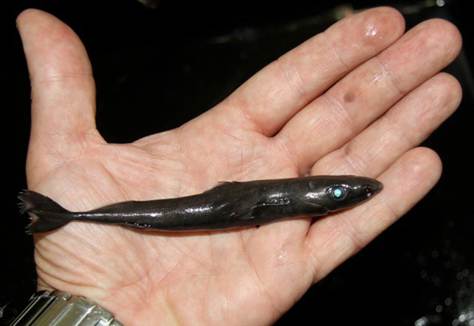VIA – MSNBC
Tiny shark has a superpower: Its belly glows
The smalleye pygmy, about the size of a human hand, likely uses it to hide from predators

Tiny sharks about the size of a human hand have a superpower of sorts: their bellies glow, according to new research that also showed these smalleye pygmy sharks use the glow to hide from predators lurking below.
Scientists had proposed the smalleye pygmy shark (Squaliolus aliae) sported light-emitting organs called photophores for use in camouflage, but that was never really tested, said study researcher Julien Claes of the Universite catholique de Louvain in Belgium. “It wasn’t even known if these organs were really functional, able to produce light,” Claes added.
The small shark, which reaches a maximum length of just 8.7 inches (22 centimeters), lives well below the water surface in the Indian and western Pacific Oceans. The new research, detailed this week in The Journal of Experimental Biology, suggests their glowing bellies (a type of bioluminescence) would replace the downwelling light from the sun, or the moon and stars, that is otherwise absorbed by their bodies.


The glowing skin of the smalleye pygmy shark, revealing its light-emitting organs called photophores.
In lantern sharks, prolactin triggers 30-minute-long bursts of light, which the sharks likely use for various means of communication. Lantern sharks use melatonin to trigger a constant belly glow used in camouflage.
The difference between the two sharks, with the pygmy shark only able to produce a constant glow, Claes said, suggests the smalleye pygmy relies on its glow for camouflage, but not communication as the lantern shark does.
The researchers also suggest both sharks evolved this ability from an ancient organism that would have used these hormones to change their skin pigmentation from light to dark (or vice versa) as a form of camouflage. So while melatonin would’ve lightened the skin of this predecessor, prolactin would have darkened it…
for the full article go here:
http://www.msnbc.msn.com/id/47191370/ns/technology_and_science-science/#.T5sAncVG3FJ
 Become A Sponsor!
Become A Sponsor!If you have a product or service that is a good fit for our surf community, we have opportunities for you to sponsor this blog! Download our media kit now!

